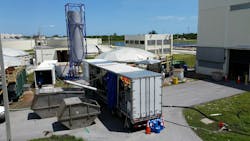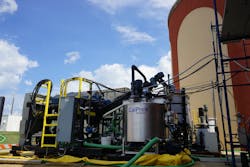Lab Analysis & Pilot Testing for Industrial Slurry Treatment
According to an EPA nutrient reduction memorandum sent to U.S. state officials in April 2022, the severity of the problem is increasing.
● Nutrients are the most widespread stressors impacting rivers and streams, with 58% and 45% of lakes having excess phosphorus levels.
● About two-thirds of the nation’s coastal areas and more than one-third of the nation’s estuaries are impaired by nutrients.
● Excess nutrients contribute to harmful algal blooms, areas of low oxygen known as “dead zones,” and high levels of nitrates that contaminate waters used for recreation, drinking water, wildlife, pets and livestock, and aquatic life.
Recent Trends in Phosphorus Discharge Limit Regulations
Phosphorus discharge limits and nutrient reduction strategies have ramped up in states, including Florida, Texas, Colorado, Idaho, Washington, and Oregon. Colorado implemented Regulation 85 2012 for more stringent regulation of “point source” nutrient dischargers such as wastewater treatment plants and companies producing wastewater in production processes. Nonpoint sources, including agriculture, were discussed in the regulation, but mandatory requirements had not yet been implemented. The data was used to determine future regulatory decisions in 2022 and beyond.
Regulations and monitoring are occurring in other states across the U.S. Any source of wastewater discharge is held to more inflexible phosphorus limits and monitoring and plans must be put into place to comply in the years to come.
Impact of Increasing Energy Costs on Wastewater Treatment
According to the EPA, along with nutrient management challenges, a significant amount of energy use occurs at water and wastewater treatment facilities. As energy costs increase, plant operators, look for cleaner and greener approaches to treating wastewater.
Working with a nutrient recovery and sludge optimization expert will help determine the best wastewater system solution for a specific application. There are custom technologies available that are affordable and safe for plants of all sizes.
Nutrient Management Regulations: Municipal vs. Industrial Wastewater Treatment Plants
Wastewater treatment in municipal and industrial applications can be vastly different. Compared to municipal wastewater, industrial wastewater often contains pollutants that are variable, concentrated, and toxic. Many industrial wastewater treatment systems are analyzed similarly to municipal systems. In reality, they may require more advanced levels of analysis, testing, and innovative systems put into place.
Many factors differentiate the complex nature of industrial treatment facilities from conventional sewage treatment plants. Industrial treatment plants that mimic the design and operation of domestic/municipal sewage plants frequently face critical challenges or even failure. Many undergo costly modifications to achieve any level of satisfactory operation.
Think Outside the Box
As organizations in industrial sectors and wastewater treatment plants face increasingly strict regulatory controls for biosolids management, a one-size-fits-all approach is not the answer. To get the quality and performance needed from environmental equipment and processes, industrial plant operators should consider customized solutions. A customized approach to fit specific industrial challenges opens the door to more efficient solutions that help meet plant goals and solve environmental challenges.
Centrisys/CNP’s approach to biosolids processing in various industries, including animal waste and manure, food processing, mining and minerals, oil and gas, and others, make customization a key differentiator in a process that starts with:
● Listening to customers and consulting engineers to understand the plant goals and challenges;
● Lab analysis for the abrasiveness, corrosiveness, and nature of the solids;
● Evaluating the process conditions of a customer’s operation;
● Pilot testing on-site;
● Adapting the equipment design and recommending technologies based on the lab pilot testing and site conditions; And
● Prototyping and testing design concepts.
“Having a great partner is critical. Working with Centrisys/CNP allows us to combine our expertise and build a top-tier centrifuge specifically for dairy manure separation,” said Scott Brown with Dairy Specialists. “Since 2006, it’s been a joint effort to ensure that my customers receive the best centrifuge possible.”
Sample Analysis is the First Step for Industrial Sludges
Assessing phosphorus recovery or removal is a viable option for an industrial plant. This is achieved by working with a knowledgeable partner that has the proper resources to offer in-depth sample analysis, pilot testing, and the equipment and optimization technologies to provide results that exceed expectations.
As a first step, a small-scale sample analysis gives plant operators better insight into their process feasibility, optimization, equipment scaling, and how to maximize efficiencies. Sludge samples are tested and analyzed, the data is reviewed, and next step recommendations are provided by process engineers and R&D teams. The Kenosha, Wisconsin-based Centrisys/CNP employs this practice in their processing lab. The lab evaluates:
● Solids Analysis (total - dissolved - suspended or volatile solids);
● Polymer and Coagulant Screening;
● Clarification, Dewaterability, Particle-size, and Nutrient Analysis; And
● Biological Methane Testing – Centrisys/CNP partners with Marquette University in Milwaukee, Wisconsin.
Pilot Testing for Nutrient Management Planning
The next analysis step may be a full-scale pilot test which provides proof of concept used to demonstrate the viability of equipment and/or a process on-site at a plant. A pilot test helps to better determine the equipment sizing, throughput, solids capture, cake solids, and polymer selection.
Using the data collected from a plant's sludge or slurry gives the Centrisys/CNP team more precise information. This allows the team to make accurate recommendations that meet or exceed regulations stipulations and performance goals.
Centrisys/CNP invested in mobile pilot testing systems for all Centrisys/CNP equipment and processes. This allows engineering and service technicians to conduct pilot and lab testing in the field and prove process performance validation at customer sites.
Technology Advancements in Treatment for Sludge, Wastewater, and BiosolidsOperating as both a biosolids equipment manufacturer and an environmental process developer gives Centrisys/CNP the ability to continue pioneering the advanced treatment for sludges, slurries, water, wastewater, and biosolids, a few of which include:
Sludge Dewatering and Thickening: Not all industrial processes are the same. Customized dewatering or thickening centrifuges achieve the best process performance than standard centrifuge designs. Centrisys/CNP’s CS Series decanter centrifuges and the THK Series sludge thickener centrifuges have custom design options to meet or exceed the requirements for industrial processes and stay in compliance with environmental and legal regulations.
CalPrex®: As a pre-digestion P-recovery or removal process for plants with high phosphorus loads, CalPrex® recovers phosphorus as brushite, which can be sold as a fertilizer to offset operational costs. The CalPrex® process was developed by Dr. Phillip Barak and the University of Wisconsin Department of Soil Science.
MagPrex™: As a post-anaerobic digestion P-recovery or removal process that turns nuisance struvite into crystals, which can be used as a fertilizer when harvested, MagPrex™ can reduce dewatering polymer costs and improve dry cake solids for lower disposal costs. There are currently eight MagPrex™ installations throughout the U.S., including Denver, Colorado, the world’s largest phosphorus recovery installation from digested sludge.
PONDUS™: For select industrial plants, a PONDUS™ thermal hydrolysis process (THP) can increase biogas production and digester capacity while reducing sludge volume and polymer consumption. There are currently 13 PONDUS™ installations worldwide, including the Kenosha (Wisconsin) Water Utility.
Custom designing and combining these Centrisys/CNP technologies for specific operations, or retrofitting into existing infrastructures, provides results that often far exceed expectations.
Generating Class A Biosolids to Reduce Volume
Thermal drying is a treatment process that evaporates the water from the sludge or slurry. By reducing the moisture content, a plant attains a drier solids content, decreases sludge volume, and reduces its environmental impact. The dry granular product created costs less to transport and is useable for land application.
Centrisys’ DLT dryer is a simple, closed-loop, hot water heating system. The waste heat from pyrolysis or CHP cooling water can be used to offset energy requirements. The low-profile design integrates modular heat exchangers into the dryer system. The DLT’s heat recovery system has individual heat exchangers for each module, making it quick and efficient to clean and increasing uptime. This low-temperature sludge belt dryer also:
● Reduces sludge volume and costs for disposal;
● Produces a dryness level greater than 90%;
● Reduces biosolids weight up to 80%;
● Meets class A requirements;
● Optimized particle size creates minimal dust and allows for land application; And
● Meets Build America, Buy America (BABA) Act standards.
Sludge dewatering and thickening and the implementation of advanced biosolids treatment are only growing and advancing. Keep operations running efficiently and within current regulation guidelines by working with partners that continue to develop innovative equipment and processes.
To learn more about Centrisys/CNP’s nutrient recovery and sludge optimization solutions, visit www.centrisys-cnp.com.



